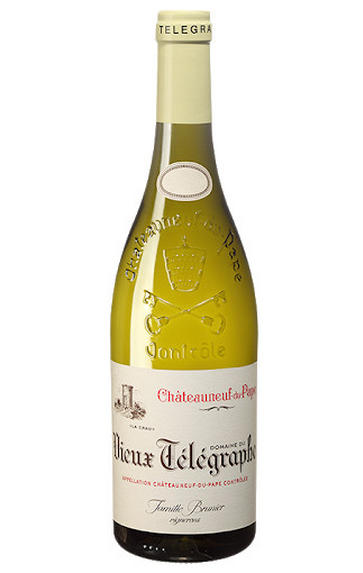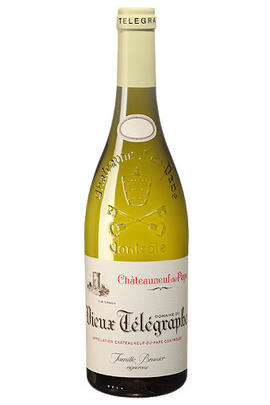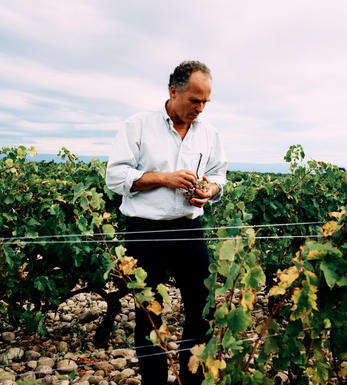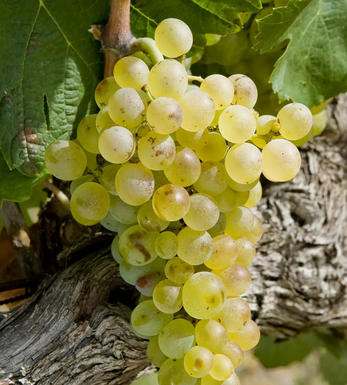
2019 Châteauneuf-du-Pape Blanc, La Crau, Domaine du Vieux Télégraphe, Rhône

About this WINE

Vieux Telegraphe
Vieux Télégraphe is one of the most renowned estates in the Southern Rhône. Blessed with the finest locations in the area on the famed La Crau plateau, there is an emphasis on terroir expression and natural winemaking. The Bruniers, who own the property, started their love affair with La Crau in 1898 and on which they now own 70ha. This plateau – a Grand Cru equivalent in Châteauneuf-du-Pape – is so reputed for several reasons. Firstly, its galets roules (pudding stones) that re-emit the heat of the sun, producing a warm microclimate ideal for even berry ripening. Beneath these lies a subsoil of clay, which counters excess heat by keeping the vines hydrated and cool. Finally, at 120m altitude, it sits higher than surrounding areas. This brings exposure to wind (notably the Mistral), which again keeps the vines cool and free from diseases (and occasionally frost).
In 2021, the domaine was lucky to have been spared the worst of the flash frost that hit the region in April. Pallières was slightly impacted, but Piedlong and La Crau both emerged unscathed. The family did, nonetheless, see a moderate drop in yield due to the rains, with Vieux Télégraphe down by about 30%. Winemaker Daniel Brunier describes the vintage as classic, breaking the long series of “solaire” vintages we’ve seen since 2015. The wines show freshness but the slow and complete ripening brought about by a later-than-usual harvest brought with it concentration of flavours and balance. Daniel believes the wines will produce some wonderful surprises throughout the course of their ageing.
Alongside their Châteauneuf properties, the Brunier family owns Domaine des Pallières in Gigondas – a mixed farming estate set within the Provençal Forest. There they were not impacted by the rains (or indeed frost) in the same way. Daniel is extremely proud of the vintage. He describes the wines as pure, linear, with more moderate levels of alcohol and showing great sophistication and balance. He believes his Racines to be one of the best he has ever made.

Châteauneuf-du-Pape
The most celebrated village of the Southern Rhône, Châteauneuf-du-Pape is the birthplace of the now indispensable French Appellation d’Origine Contrôlée system – imperfect though it may be. Compared to the Northern Rhône, the vineyards here are relatively flat and often feature the iconic galet pebbles – the precise benefits of which are a source of much debate. Minimum alcohol levels required by the AOC are the highest in France, but at 12.5% it is well below the natural generosity of Grenache, which only achieves its full aromatic potential when it is fully ripe and laden with the resultant high sugars. Syrah and Mourvèdre contribute the other defining elements in the blend, adding pepper, savoury spice and structure to the decadent Grenache. There are a further 10 permitted red grape varieties which can be used to adjust the “seasoning”. Of the five white varieties permitted, it is Grenache Noir’s sibling – predictably perhaps – Grenache Blanc, which dominates, though Roussanne shows a great deal of promise when handled well, notably at Château de Beaucastel.

Clairette
Clairette is a white grape with a long history and is widely grown in various wine regions, particularly in France and other Mediterranean countries. It is known for producing wines with diverse styles, from dry to sweet and sparkling to still.
The variety is believed to have originated in the Rhône Valley, with historical references dating back to the 16th century. Nowadays, it is grown in several other Mediterranean regions, including Provence, Languedoc-Roussillon, Southern Rhône, and certain areas in Spain, Italy, and Algeria.
Clairette is a vigorous and high-yielding vine, making it relatively easy to grow in the vineyard. It prefers warm and sunny climates, which need plenty of sunlight to ripen fully. The grape clusters are medium-sized and compact.
The wines can vary in style, depending on the region and winemaking techniques. In some areas, it is used in blends to add acidity and structure, while in others, it can be the dominant grape in varietal wines.
The dry white wines typically exhibit delicate aromas of white flowers, citrus fruits, and sometimes hints of herbs. In certain regions, the variety is used to make sweet wines, either as a late-harvest style or as a component in fortified wines, such as the famous Muscat de Beaumes-de-Venise. Clairette is also used to produce sparkling wines, adding freshness and acidity to the blends.


Buying options
Add to wishlist
wine at a glance
Delivery and quality guarantee